When we are working with athletes we use a number of metrics to designate their sessions. With new runners we always start with describing the session in terms of the words: Easy; Steady; Tempo and Fast. These are to get an athlete to feel how they run; the actual pace will be determined by how the runner is feeling that day. If they’ve had a bad day at work or they are tired from an overload of social, family or work commitments and it’s cold and raining then a tempo run is potentially going to be slower than if they have just had a pay raise, the sun is shining and they are full of the joys of spring. However both are tempo runs in terms of effort it is merely pace that is different. As a Coach utilising these words is useful because when athletes are tired we don’t need to make things worse by showing the runner that they are going slowly.
To explain the above runs in terms of effort Easy runs allow the runner to see improvement without breaking down. These should feel relaxed with easy breathing and the ability to hold a conversation whereas a Fast runs need no explanation and we will use these over short intervals or repeats. Tempo runs are where runners start to stretch their physical boundaries. They are often described as controlled discomfort and require concentration. You can utter a word or two but no more! As you get fitter and stronger you constantly will push the envelope on these runs - they never get easy you just get faster!
Perhaps the most difficult runs to get to grip with are the Steady runs. These are the bread and butter sessions, the "miles in the bank". These runs build your aerobic base that acts as the foundation for the rest of your training and are usually found to be on or around marathon pace. Conversations are possible in short sentences rather than a long conversation. One thing with these runs I believe is not to go too slowly but the idea is to FEEL what steady is.
As a runner progresses and looks to achieve a certain goal however then of course accurate pace sessions will come into the equation. After all if a marathon runner is looking to break 3 hours 30 mins then they need to understand what 8:00 min per mile pace feels like, and to train at and around that exact pace. Here we would look to ensure that whilst some of the steady runs are to feel some of the long steady runs are not conducted too slowly and are to pace. For meaningful Steady Runs a useful metric I find is to take the time per 400m of the runners best 1500 metre time and add 20 seconds. So to explain; if we take our 3 hours 30 mins marathon runner I would expect them to have a best mile time of around 6 mins 30s or 98 seconds per 400m. Thus 98 + 20 secs = 118 secs = 7 mins 52 secs per mile as a steady pace in those meaningful shorter steady runs which is not a million miles away from their marathon pace of 8 mins per mile. As a coaching tool it is a good ready reckoner to use in some of these shorter steady sessions.
By incorporating easy, steady, tempo and fast running into your own training whilst mixing up the use of feel and actual pace no energy system is ever neglected. Throughout the year almost every system, whether it's aerobic, anaerobic, or neuromuscular, is worked on and we do this with our athletes from middle distance athletes to those running ultra marathons. We do however emphasise different elements during different phases of training. So why not calculate your own steady pace using the formula above and give it a go and let us know how you get on.
Run SMART!

